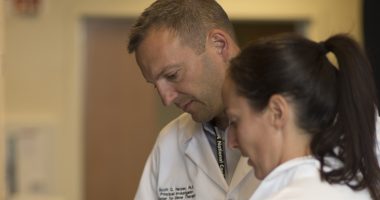Gene Therapy Rescues Muscle, Eases Defects in Mice With Severe CMT2D

A gene therapy delivering instructions to produce the neurotrophin-3 (NT-3) protein to muscle cells improved muscle function and eased defects in nerve and muscle structure of a mouse model of severe Charcot-Marie-Tooth disease type 2D (CMT2D), a study found.
These results support an NT-3 gene therapy as a potential treatment approach for CMT2D and potentially for other CMT subtypes, its researchers wrote.
The study, “AAV1.NT-3 gene therapy in a CMT2D model: phenotypic improvements in GarsP278KY/+ mice,” was published in the journal Brain Communications.
CMT2D is caused by mutations in the GARS gene. This gene contains the instructions for making glycyl-tRNA synthetase, a protein that belongs to a group of enzymes that mediate the binding of amino acids — the building blocks of proteins — to an RNA molecule. This is the key first step in protein production.
A mouse model with a mutated Gars gene (the mouse form of GARS) showed early and severe damage to the nervous system, with reductions in the size of nerve cell fibers (called axons) and a slower transmission of information between nerve cells. These animals had impairments in the neuromuscular junction (NMJ), the place where neurons and muscle fibers communicate to control movement.
NT-3 is a protein that supports the survival of Schwann cells, those responsible for the production of myelin in the peripheral nervous system (outside the brain and spinal cord). Myelin is the fatty substance that surrounds nerve cell axons, facilitating the proper transmission of signals throughout the nervous system.
Further studies have shown that it also plays a role in NMJ maintenance and in the growth of muscle fibers.
Researchers at The Abigail Wexner Research Institute, in Ohio, assessed the potential of an NT-3 gene therapy in treating muscle disease. They tested it in two mouse models carrying different mutations in the Gars gene, resulting in a milder and in a more severe disease form.
NT-3 was delivered to cells using a modified viral vector, ensuring that only muscle cells would be able to produce this protein. The therapy was injected into the calf muscles of mice in both disease groups, while age-matched animals in each model were given a control solution.
The treatment’s efficacy was assessed using the rotarod test, which measures coordination and balance, as well as with nerve conduction tests. The researchers also looked for changes in the peripheral nervous system, the NMJ, and muscles.
In mice more severe disease, these measures were assessed 12 weeks after the injection, whereas in the milder disease model they were assessed after 30 weeks.
NT-3 gene therapy given to mice with severe disease led to an improved performance in the rotarod test — by 33% — compared to untreated control animals. Nerve conduction tests also showed a significant increase of 42% versus controls. No significant differences in these measures were seen between treated and untreated animals with milder symptoms, “which might be related to the milder manifestation” of disease in these mice, the researchers wrote.
In both models, the gene therapy led to an increase in myelin thickness of the sciatic nerve (the longest nerve in the human body) when compared to their controls. Also, the abnormal structure of the NMJ lessened in mice with severe disease, with these animals showing a 32% increase in the supply of nerves at NMJs compared with controls.
The gene therapy also led to marked improvements in muscles structure in both mouse models, with a significant decrease of abnormally small and enlarged muscle fibers.
Further analysis revealed that the benefits of the NT-3 gene therapy may be related to a restoration of mitochondrial function in the CMT mouse models. Mitochondria, as energy-producing factories in cells, are particularly important in muscle.
Researchers found that the levels of key mitochondria proteins were boosted by the gene therapy.
“Neurotrophin 3 gene transfer therapy has disease modifying effect in a mouse model for Charcot–Marie–Tooth disease type- 2D, leading to meaningful improvements in peripheral nerve myelination and neuromuscular junction integrity,” the researchers concluded.
These findings support the potential benefit of NT-3 for other CMT disease subtypes, they added.







